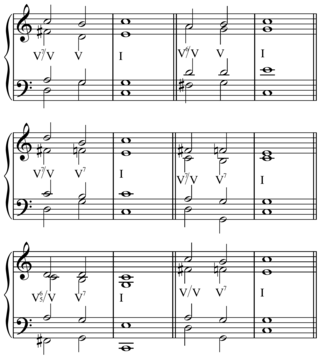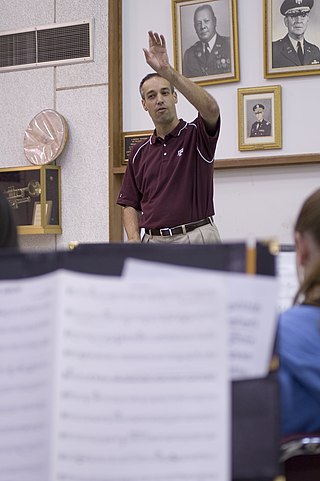
"Hands Across the Sea" is an American military march composed by John Philip Sousa in 1899. [1]

"Hands Across the Sea" is an American military march composed by John Philip Sousa in 1899. [1]
The march was written in 1899. When the march premiered the same year at the Academy of Music in Philadelphia, the audience insisted that it be repeated three times. [2] The march is "addressed to no particular nation, but to all of America's friends abroad." [3]
In 1901, John Philip Sousa heard the Virginia Tech Regimental Band (The Highty-Tighties) playing "The Thunderer" at the Pan-American Exposition in Buffalo, New York. Sousa was so impressed that he dedicated a performance of his latest march, "Hands Across the Sea", to the band. [4]
Sousa prefaced the sheet music's score with a quotation from the English diplomat John Hookham Frere: "A sudden thought strikes me; let us swear eternal friendship." [5] [6] The march was composed in the wake of the Spanish–American War and is idealistic, in addition to patriotic, in nature. [5]
"Hands Across the Sea" remains one of Sousa's more popular marches and is still performed widely by bands. [3]
One reviewer describes the march this way: "Hands Across the Sea opens with a jaunty, carefree theme, the wind sonorities light and generally in their middle and upper ranges. An equally attractive march appears midway through, its manner initially mellow and nonchalant. It gradually turns more animated and colorful, the piccolo dancing merrily above suave wind sonorities. The work closes with this spirited theme playing proudly, the brass flamboyant, the cymbals crashing, and the whole brimming with festivity and vivid color. For band music enthusiasts and Sousa mavens, this three-minute gem will have great appeal." [5]
Ragtime, also spelled rag-time or rag time, is a musical style that had its peak from the 1890s to 1910s. Its cardinal trait is its syncopated or "ragged" rhythm. Ragtime was popularized during the early 20th century by composers such as Scott Joplin, James Scott and Joseph Lamb. Ragtime pieces are typically composed for and performed on piano, though the genre has been adapted for a variety of instruments and styles.

John Philip Sousa was an American composer and conductor of the late Romantic era known primarily for American military marches. He is known as "The March King" or the "American March King", to distinguish him from his British counterpart Kenneth J. Alford. Among Sousa's best-known marches are "The Stars and Stripes Forever", "Semper Fidelis", "The Liberty Bell", "The Thunderer", and "The Washington Post".

A symphony is an extended musical composition in Western classical music, most often for orchestra. Although the term has had many meanings from its origins in the ancient Greek era, by the late 18th century the word had taken on the meaning common today: a work usually consisting of multiple distinct sections or movements, often four, with the first movement in sonata form. Symphonies are almost always scored for an orchestra consisting of a string section, brass, woodwind, and percussion instruments which altogether number about 30 to 100 musicians. Symphonies are notated in a musical score, which contains all the instrument parts. Orchestral musicians play from parts which contain just the notated music for their own instrument. Some symphonies also contain vocal parts.

American march music is march music written and/or performed in the United States. Its origins are those of European composers borrowing from the military music of the Ottoman Empire in place there from the 16th century. The American genre developed after the British model during the colonial and Revolutionary periods, then later as military ceremonials and for civilian entertainment events.
"The Liberty Bell" (1893) is an American military march composed by John Philip Sousa.

A concert band, also called a wind band, wind ensemble, wind symphony, wind orchestra, symphonic band, the symphonic winds, or symphonic wind ensemble, is a performing ensemble consisting of members of the woodwind, brass, and percussion families of instruments, and occasionally including the harp, double bass, or bass guitar. On rare occasions, additional, non-traditional instruments may be added to such ensembles such as piano, synthesizer, or electric guitar.

"The Stars and Stripes Forever" is a patriotic American march written and composed by John Philip Sousa in 1896. By a 1987 act of the U.S. Congress, it is the official National March of the United States of America.

Frederick Fennell was an American conductor and one of the primary figures which promoted the Eastman Wind Ensemble as a performing group. He was also influential as a band pedagogue, and greatly affected the field of music education in the US and abroad. In Fennell's New York Times obituary, colleague Jerry F. Junkin was quoted as saying "He was arguably the most famous band conductor since John Philip Sousa."

"The Fairest of the Fair" is a 1908 march by John Philip Sousa. One of Sousa's more melodic, less military marches, it was composed for the annual Boston Food Fair of 1908. It is claimed that the memory of a pretty girl he had seen at an earlier fair inspired the composition.

In music theory, voicing refers to two closely related concepts:

The United States Navy Band, based at the Washington Navy Yard in Washington, D.C., has served as the official musical organization of the U.S. Navy since 1925. The U.S. Navy Band serves the ceremonial needs at the seat of U.S. government, performing at presidential inaugurations, state arrival ceremonies, state funerals, state dinners, and other significant events.

The Dallas Winds is a professional concert band based in Dallas, Texas.
The Cincinnati Pops Orchestra is a pops orchestra based in Cincinnati, Ohio, United States, founded in 1977 out of the Cincinnati Symphony Orchestra. Its members are also the members of the Cincinnati Symphony, and the Pops is managed by the same administration. Erich Kunzel, the Pops' founding conductor, continued to lead the Pops until his death in 2009.
"Manhattan Beach" is an American march by John Philip Sousa (1854–1932). It was written in 1893 to commemorate the Manhattan Beach Park resort. It follows this march style: Intro(4 bars)--[:A(16):]--[:B(16):]--Trio [:C(16):]--[:D(16):]. In part D, the tune starts quietly, grows louder and fades away. The march is notable for lacking a "stinger" or tutti chord on beat two.
"The Thunderer" is a march composed by John Philip Sousa in 1889. The origin of the name is not officially known, though it is speculated that the name is attributed to Myron M. Parker, a prominent DC politician and Freemason. It is also one of Sousa's most famous compositions.
"The Gladiator" is a march by John Philip Sousa, written in 1886 while Sousa was leader of the US Marine Band.

"The High School Cadets" is a march written in 1890 by John Philip Sousa in honor of the cadet drill team of Washington High School in the District of Columbia. It is in regimental march form (I-AA-BB-CC-DD) and is a popular selection for school concert and marching bands, as well as for professional orchestras and bands. The march has been arranged for a wide variety of instruments and ensembles, and has been frequently recorded, including at least two recorded performances by Sousa's own band. The march's final strains were featured in the 1939 film The Under-Pup.

Dr. Timothy Brett Rhea is director of bands and music activities at Texas A&M University. As director of bands, he leads the university band program, serves as conductor of the Texas A&M Wind Symphony, and coordinates the Fightin' Texas Aggie Band marching band. As director of music activities, he administratively oversees the activities of the jazz, orchestra, and choral programs. Rhea also served as the 79th president of the American Bandmasters Association from 2016-2017.
King Cotton is a military march composed in 1895 by John Philip Sousa, for the Cotton States and International Exposition (1895).
Keith Brion is an American classical conductor and band leader.